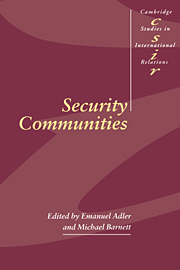Book contents
- Frontmatter
- Contents
- Notes on contributors
- Acknowledgements
- Part I Introduction and theoretical overview
- Part II Studies in security communities
- 3 Insecurity, security, and asecurity in the West European non-war community
- 4 Seeds of peaceful change: the OSCE's security community-building model
- 5 Caravans in opposite directions: society, state and the development of a community in the Gulf Cooperation Council
- 6 Collective identity and conflict management in Southeast Asia
- 7 An emerging security community in South America?
- 8 Australia and the search for a security community in the 1990s
- 9 The United States and Mexico: a pluralistic security community?
- 10 No fences make good neighbors: the development of the US-Canadian security community, 1871–1940
- 11 A neo-Kantian perspective: democracy, interdependence and international organizations in building security communities
- Part III Conclusions
- Index
- CAMBRIDGE STUDIES IN INTERNATIONAL RELATIONS
4 - Seeds of peaceful change: the OSCE's security community-building model
Published online by Cambridge University Press: 30 October 2009
- Frontmatter
- Contents
- Notes on contributors
- Acknowledgements
- Part I Introduction and theoretical overview
- Part II Studies in security communities
- 3 Insecurity, security, and asecurity in the West European non-war community
- 4 Seeds of peaceful change: the OSCE's security community-building model
- 5 Caravans in opposite directions: society, state and the development of a community in the Gulf Cooperation Council
- 6 Collective identity and conflict management in Southeast Asia
- 7 An emerging security community in South America?
- 8 Australia and the search for a security community in the 1990s
- 9 The United States and Mexico: a pluralistic security community?
- 10 No fences make good neighbors: the development of the US-Canadian security community, 1871–1940
- 11 A neo-Kantian perspective: democracy, interdependence and international organizations in building security communities
- Part III Conclusions
- Index
- CAMBRIDGE STUDIES IN INTERNATIONAL RELATIONS
Summary
The essence of European security lies in the process of creating an inclusive community of democratic states. This is the special genius of the CSCE … In this sense, free elections are as much a security measure as ceilings on tanks.
James GoodbyIn this chapter, I introduce and analyze the concept of a “security community-building institution.” I argue that collective identities, the “stuff” of which security communities are made, do not always evolve spontaneously; rather, as in the case of the expansion eastward of the Euro-Atlantic pluralistic security community, they are socially constructed by institutions. Although some international institutions - including the European Union (EU) and the North Atlantic Treaty Organization (NATO) - have, as a collateral outcome of their functional tasks, helped set up some of the building-blocks of security communities, none has gone as far as the Organization for Security and Cooperation in Europe (OSCE) in transforming itself into an understanding in the concept of pluralistic security community.
When taken together, the OSCE's innovative security communitybuilding processes and practices suggest a new model of international security. According to this “association-exclusion” - I prefer to call it inside-out - model, security is increasingly defined as “comprehensive” (it links classic security elements to economic, environmental, cultural, and human-rights factors), “indivisible” (one state's security is inseparable from that of other states), and “cooperative” (security is based on confidence and cooperation, the peaceful resolution of disputes, and the work of mutually reinforcing multilateral institutions).
- Type
- Chapter
- Information
- Security Communities , pp. 119 - 160Publisher: Cambridge University PressPrint publication year: 1998
- 48
- Cited by

